If you’re like most people, the back of your entertainment center is probably a mess of wires. But, why do you need so many wires connected to your TV and what exactly do they all do? Here is a quick reference to help explain some of the most common cables you may have and what they are used for. And if you are sick of all the messy cables, we have also thrown in a couple tips to help you organize them.
Coaxial Cable
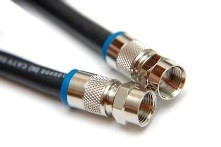 Coaxial Cable is a copper-based cable used primarily for audio and video purposes. It is commonly used to connect your TV to a cable TV service/provider, like ImOn. In fact, you probably have at least one coaxial cable wall outlet in almost every room of your home. Besides bringing you your ImOn cable TV service, coaxial cable can also be used with other receivers, cable boxes, antennas, and modems.
Coaxial Cable is a copper-based cable used primarily for audio and video purposes. It is commonly used to connect your TV to a cable TV service/provider, like ImOn. In fact, you probably have at least one coaxial cable wall outlet in almost every room of your home. Besides bringing you your ImOn cable TV service, coaxial cable can also be used with other receivers, cable boxes, antennas, and modems.
Component Cables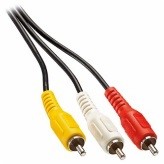
If you have an older HDTV or an SDTV you probably use component cables to connect your DVD player or gaming console to your TV. Component cables are a set of three cables usually colored red, yellow, and white. The yellow cable provides the TV picture while the red and white cables provide the audio. While component cables do provide high-performance video connection from HDTVs to DVD players and game consoles, they are still digital-to analog conversions that can degrade the quality. They have been replaced by HDMI cables as the preferred connection method for high-definition video.
HDMI Cables
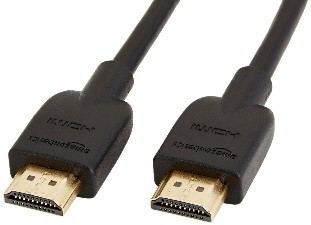 HDMI Cables stands for High-Definition Multimedia Interface cables and are the new standard in providing both audio and video transmission for high definition televisions. A single HDMI cable will provide both HD picture and sound and can be used for connecting Blue-Ray players, HD-capable digital cable boxes, computers, and over-the-top media players to your HDTV. The HD video and audio content is transmitted digitally through the HDMI cable which means there is little to no signal degradation, even over long distances. For more on HDMI cables and their uses visit https://www.techwalla.com/articles/what-is-an-hdmi-cable-used-for
HDMI Cables stands for High-Definition Multimedia Interface cables and are the new standard in providing both audio and video transmission for high definition televisions. A single HDMI cable will provide both HD picture and sound and can be used for connecting Blue-Ray players, HD-capable digital cable boxes, computers, and over-the-top media players to your HDTV. The HD video and audio content is transmitted digitally through the HDMI cable which means there is little to no signal degradation, even over long distances. For more on HDMI cables and their uses visit https://www.techwalla.com/articles/what-is-an-hdmi-cable-used-for
Digital Optical Audio Cables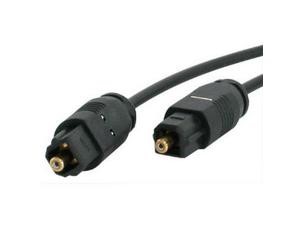
A Digital Optical Audio cable is a fiber optic cable used to connect DVD players or a set-top box to a sound bar or home theater system. Because it is a fiber optic cable, it transmits pure high-quality audio through light. Note that some audio components have moved to using HDMI instead of a Digital Optical Audio Cable, but there are still many products new and old that use this type of cable.
USB
USB stands for Universal Serial Bus and is the most popular connection used to connect a computer to devices such as digital cameras, printers, scanners, and external hard drives. But many new TVs now have a USB port on them. This is often used for plugging in a hard drive, or flash drive, to view media files on your television.
For a diagram on where each wire plugs in on your HDTV visit: http://www.nytimes.com/interactive/2012/03/21/technology/personaltech/hooking-up-a-new-tv-which-cable-goes-where.html?_r=2&emc=ctb2_20120322&nl=technology&
Cable Organization Ideas:
Now that you know what all the TV cables do, here are a few ideas from Pinterest on how to tame the mess of cords behind your entertainment center.
Cable ties or wires:
If you are having a difficult time with unruly wires, try containing them with cable ties, wire ties, zip ties, or Velcro. You can get as high tech or low tech as you want with this. You can reuse a wire tie off a bread wrapper or spend up to $20 for rubber cable ties.
Wire Labels and ID tags: 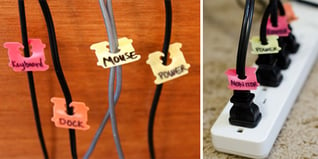
ID your plugs and wires with labels. That way you don’t have to guess which power plug and cable belongs with which gadget. You can just use masking tape and a marker or try reusing the plastic bread tags. You can also purchase ID tags and wire wraps online or at an electronic store.
3M Command hooks: 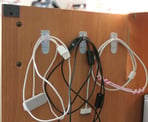
The great thing about Command Hooks is that they don’t damage your walls or cabinets, but they allow you to hang cords up to keep them off the floor. Plus they come in a variety of sizes and colors.
Sock Cable Wrap: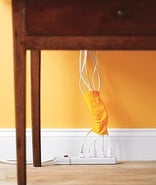
Another inexpensive way to help contain cords is by using a stretchy trouser sock. Just cut off the toe of the sock and run the cables up through the sock to keep them together. The sock contains and covers up the cords. Plus you can get a sock that is a close match to your wall color to help conceal the cords better.
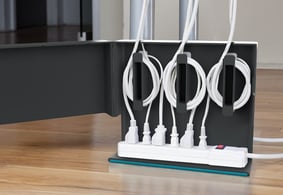 Plug Hub: If you don’t mind spending a little more money, you can purchase a Plug Hub to help organize and hide your cables. The box comes with cord wrappers to alleviate extra wiring and allows you to hide a full power strip or surge protector. The down side is that you now have a large plastic box to hide.
Plug Hub: If you don’t mind spending a little more money, you can purchase a Plug Hub to help organize and hide your cables. The box comes with cord wrappers to alleviate extra wiring and allows you to hide a full power strip or surge protector. The down side is that you now have a large plastic box to hide.
